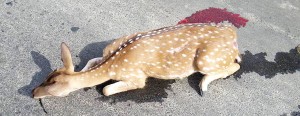News
Innocent animals die because we speed through their habitat
View(s):A doe and her fawn were killed last week by a speeding vehicle near Yala. Although roadkill is frequent in wilderness areas this accident brought tears to all those who shared the images of helpless animals lying gasping for breath on the side of the road.
A man who saw the dying animals a few minutes after they were hit said the accident occurred around 8.45 a.m. on July 27. The vehicle sped off, leaving the mortally-wounded mother and her baby, but the driver was nabbed later on. The witness, Sampath Galappaththi, who is involved in the travel trade in Yala, said this was the fifth deer hit by vehicles along this stretch of the road in July.

Double tragedy: A doe and her fawn (below) killed on the spot. Pix by Sampath Galappaththi
This route, linking Kirinda to Yala, used to be a roughly tarred road, and its uneven surface did not encourage drivers to speed, which limited animal casualties. Now, however, the road is being carpeted and vehicles are speeding on it, making it a death trap for unwary animals.
Local sources revealed the road from Kirinda through Palatupana to Yala will be carpeted upto the Yala National Park ticketing office. This stretch of the road cuts across the Nimalawa Sanctuary, so many smaller animals are probably already being killed daily, the toll unrecorded.As the road network around the country improves, particularly through wilderness areas, there is a higher chance of accidents to animals. When vehicles are driven at high speed the impact is often deadly for the animal. It is also important to understand that animals live not only in protected areas but also roam in forests in other areas.
Sri Lanka can learn from countries such as the United States and Australia where tunnels have been built under highways to allow animals to pass from one side of the road to the other without risking their lives in traffic. Experts warn that with new highways and growing population densities around the world roadkill will increase. They urge people not to throw food out of the windows as this attracts animals to the roadside.Sadly, there have been few studies about the impact of roadkill in Sri Lanka. Research surveying only reptiles and amphibian mortality on a 3km stretch of a highway crossing the Nilgala forest area recorded 552 individual animal species killed for the study period of 48 days.
The young researchers, Sameera Suranjan, Sujan Henkanaththegedara and Thasun Amarasinghe, found 72 species of herpetofauna including 53 reptiles and 19 amphibians among the roadkill. Of this, 19 species (26.3 per cent of the total) were endemic to Sri Lanka and 22 species (30.5 per cent) were listed nationally as being under threat of extinction.
 Not only small, slow-moving animals but also the largest land animals, elephants, are being hit by vehicles on several occasions.Sri Lanka needs to develop its road network but it is important to minimise animal deaths. Most of these accidents are preventable, so it is important to identify the stretches where roadkill is high. Speed limits, warning signs and speed bumps are among immediate remedial actions that can be taken. It is time to review the prudence of building roads through protected wilderness areas.
Not only small, slow-moving animals but also the largest land animals, elephants, are being hit by vehicles on several occasions.Sri Lanka needs to develop its road network but it is important to minimise animal deaths. Most of these accidents are preventable, so it is important to identify the stretches where roadkill is high. Speed limits, warning signs and speed bumps are among immediate remedial actions that can be taken. It is time to review the prudence of building roads through protected wilderness areas.
Ultimately, it is the duty of all who drive through these areas to be vigilant and drive carefully.

